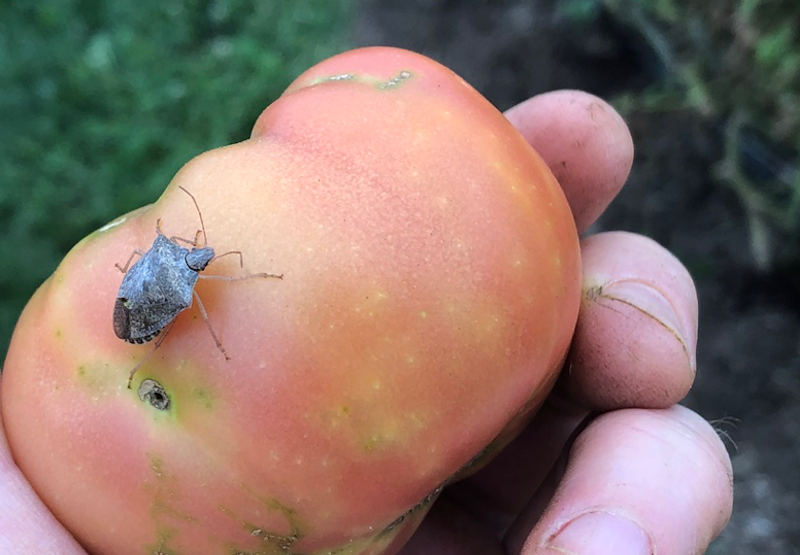Is something eating up your plants or spreading disease in a newly planted garden? Here are seven easy strategies for chemical-free control of pests, weeds and disease that you can try now.
Following a year of pandemic restrictions and shelter in place, interest in local, self-reliance continues with more community members drawn to backyard food production. Likewise, many from this growing cohort of urban homesteaders have a personal preference for non-chemical and/or organic practices.
As we move into summer, the environmental conditions that contribute to peak production of our favorite fruit and vegetable crops will also cater to a rise in garden pests, weeds and disease. Whether it’s the scourge of leaf spot on tomatoes, caterpillars feasting on your broccoli or noxious weeds like johnsongrass overgrowing the plot, it all can make the most fervent organic grower rethink the cost-reward of their kitchen garden.
Moreover, with fewer organic pest control products available in the garden aisle, it may seem like an uphill battle to live your garden values. That’s why I always stress that beginning gardeners, especially those who prefer natural growing methods, familiarize themselves with the principles of integrated pest management (IPM). IPM is a science-based field of study and systems approach to protecting crops, livestock, landscapes and infrastructure from pest damage with the least environmental, health and economic risks.
IPM in the garden relies on preventive measures, forecasting and monitoring to reduce reliance on chemical controls. While there are more common insect, weed and disease issues than can be covered in any one article, there is a more concise set of gardening principles which can greatly reduce the impact of plants problems and the need for pesticides. Here are a few ideas to consider:
- Scouting and monitoring – The opposite of set it and forget it, you should get up close and personal with your plants. Multiple times a week, manually scout for pests and disease issues by taking your hand to gently move plant and reveal all hidden parts especially at the base of the stem and undersides of leaves. Consider setting up yellow sticky traps in the garden for bug pests or take a clipboard with a white sheet of paper and shake plants over the top to expose unseen pests and identify them before deciding on a treatment. It doesn’t take more than a few minutes, but scouting on a weekly basis can help you catch issues before they are past the point of no return.
- Identify the problem – Not sure what you’ve observed during your garden scout? Always use a reputable plant problem diagnostic tool like K-State’s Pocket Guide for Pests and Beneficials or contact the Johnson County Garden Hotline at [email protected] or 913-715-7050.
- Crop rotation – The physical movement of closely related plant families in the garden can greatly reduce incidence of host-specific disease and insects that concentrate in a specific part of your plot. Rotating a diverse mix of plants and cover crops over multiple year rotations is one of the most efficient IPM tools for disrupting plant damage.
- Cultural practices – Careful attention to environmental factors like plant spacing, soil temperature, full sun, soil amending, timely irrigation, regular weeding and mulching will go a long way towards pest and disease control. Check out K-State’s Garden Guide for a crash course on the best practices.
- Physical barriers – Applying netting and lightweight row covers draped over sturdy plants or support structures, like low tunnels or larger trellis for trees and bushes, can be an excellent way to exclude birds and bugs. Wettable powders like kaolin clay can create a light film directly on the plants which can also reduce insect feeding. This practice is an especially effective prevention tool with low growing crops that are routinely damaged by feeding, i.e. squash, berries, cabbages, bush beans. Just remember to remove fine mesh insect covers regularly for crops that require pollinator access to produce fruit. To remove large areas of weeds, the use of silage tarps or plastic sheeting fastened to the ground can be used to block light and overheat soil to destroy invasive weeds and avoid herbicides.
- Habitat for beneficial insects – Planting vegetative strips of flowering and native plants and tall grasses in and around the garden can support habitat for beneficial insects and other predators that consume or lay their eggs on/inside plant pests. Include many plant species in your landscape to promote flowering throughout the growing season. Consider leaving space for trap crops around garden boarders to lure pests away from your prized plant varieties.
- Resistant varieties – Don’t be fooled by the best looking seed pack. Avoid plant plagues by selecting cultivars with known resistance or tolerance for most common disease problems in a given crop type. Cornell University maintains a great up to date list of Disease Resistant Vegetable Varieties, and K-State offers a list of recommended Small- and Tree-Fruit Cultivars.
Although there are several organic approved insecticides, fungicides and other chemical controls that can be more effective and a safer alternative for the home gardener, these products are not without their own environmental risks, and they should only be used when all other IPM boxes are checked. Sustainable food production is about more than buying organic labeled products or applying only naturally derived substances. Successful organic food production depends on observation, curiosity, learning and holistic stewardship of a diversified garden landscape.
If you’d like to learn more about IPM for gardens and small farms, sign up for the Growing Growers workshop on Insects, Disease and Weed Management, which will be held online Monday, June 28.
Story and photo: Zac Hoppenstedt, Horticulture Agent, Johnson County K-State Research and Extension

In future how about including a note about the desirability of some pests. The caterpillar on your fennel is the beautiful black swallowtail. The dreaded tomato horn worm is a fascinating distinct moth. Maybe that beetle is a soldier beetle who is stalking your pests . . .